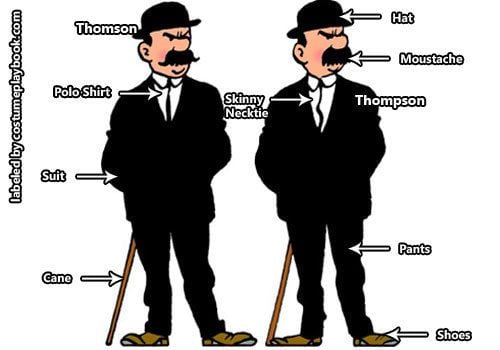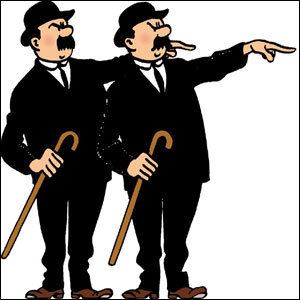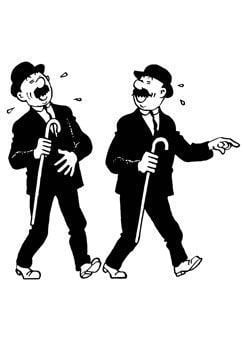Full name Thomson and Thompson | Created by Hergé Creator Hergé Played by Guy Piérauld, Paul Rieger | |
 | ||
Movie Tintin and the Temple of the Sun Similar Captain Haddock, Snowy, Professor Calculus, Bianca Castafiore, Tintin | ||
Thomson and thompson character chronicles
Thomson and Thompson (French: Dupond et Dupont) are fictional characters in The Adventures of Tintin, the comics series by Belgian cartoonist Hergé. They are two incompetent detectives who provide much of the comic relief throughout the series. While the two are apparently unrelated as they have different (albeit similar looking) surnames, they look like identical twins whose only discernible difference is the shape of their moustaches. They are afflicted with chronic spoonerisms, are extremely clumsy, thoroughly clueless, and usually bent on arresting the wrong character. In spite of this, they somehow get entrusted with delicate missions.
Contents
- Thomson and thompson character chronicles
- Character history
- Inspiration and cultural impact
- Names in other languages
- References

The detective with the flat, droopy walrus moustache is Thompson and introduces himself as "Thompson, with a 'P', as in psychology", "Philadelphia", or any other "P" word in which the initial "P" is combined with another letter, losing the initial "P" sound or else rendering it completely silent, while the detective with the flared, pointy moustache is Thomson, who often introduces himself as "Thomson, without a 'P', as in Venezuela."

Thomson and Thompson usually wear bowler hats and carry walking sticks, except when abroad: during these missions they insist on wearing the stereotypical costume of the country they are visiting so that they blend into the local population, but instead manage to dress in folkloric attire that actually makes them stand apart.

The detectives were in part based on Hergé's father and uncle, identical twins who wore matching bowler hats while carrying matching walking sticks.
Character history
Thomson and Thompson first appeared in a Tintin adventure in 1932, in Cigars of the Pharaoh, when they came into conflict with Tintin on board a ship where he and Snowy were enjoying a holiday cruise. When this adventure was first published they were referred to as X33 and X33bis (or X33 and X33b). Here they showed an unusually high level of cunning and efficiency, going to great lengths to rescue Tintin from the firing squad and save Snowy from sacrifice in disguises that fooled even Tintin. In this and two other early stories The Blue Lotus and The Black Island, they spent most of their time pursuing Tintin himself for crimes he had not committed, forced to follow official orders and faked evidence, the two noting in Blue Lotus that they never believed in Tintin's guilt even if they had to obey their orders.
Except for their codenames, they remained nameless in the early adventures. It was not until King Ottokar's Sceptre, published in 1938, that Tintin mentions their definitive names when introducing them to Professor Alembick at the airport.
In his 1941 Tintin play co-written with Jacques Van Melkebeke, Tintin in India: The Mystery of the Blue Diamond, Hergé named them as "Durant and Durand," although he later renamed them as "Dupont and Dupond." The series' English-language translators, Michael Turner and Leslie Lonsdale-Cooper, renamed them "Thomson and Thompson."
While the original version of Cigars of the Pharaoh came out in 1932, the rewritten and redrawn version was issued in 1955, and the English version was not issued until 1971. This resulted in some chronological confusion for new readers of the Tintin series, which is why the text hints that Tintin already knew the pair, and was surprised at their unfriendly behaviour; however, on the original chronological sequence, this was indeed the first time they ever met. In addition, Hergé added them to the 1946 colour version of the second Tintin story Tintin in the Congo, in the backdrop as Tintin embarks for what is now the Democratic Republic of the Congo.
Thomson and Thompson were originally only side characters but later became more important. In the redrawings of the earlier books, especially The Black Island, the detectives gained their now-traditional mannerisms.
In Land of Black Gold, the detectives mistakenly swallow some mysterious fuel-related pills that caused them to sprout immensely long beards and hair that change color constantly and grow at a break-neck pace. The condition wears off by the end of this adventure, but it relapses in Explorers on the Moon, causing problems when the captain must continuously cut their hair, repeatedly switching back to re-cut floor length hair (and mustaches and beards) which all grow back in seconds.
In the 19 books following Cigars of the Pharaoh, Thomson and Thompson appear in 17 of them, not appearing in Tintin in Tibet or Flight 714 to Sydney. In some of these books their role is minor; the duo's appearance in The Shooting Star is confined to two panels, they appear briefly only at the beginning of The Broken Ear (before being tricked into closing the case in the belief that the stolen object has been returned when it was actually replaced by a fake), and are imprisoned and face execution on false charges in Tintin and the Picaros. During their other appearances, they serve as the official investigators into whatever crimes Tintin is currently investigating.
Inspiration and cultural impact
The detectives were in part based on Hergé's father Alexis and uncle Léon, identical twins who often took walks together wearing matching bowler hats while carrying matching walking sticks. Another inspiration was a picture of two mustachioed, bowler-hatted, formally dressed detectives who were featured on the cover of the Le Miroir edition of 2 March 1919. They were shown escorting a criminal—one detective was handcuffed to the man while the other was holding both umbrellas.
They also make a brief appearance in the Asterix book Asterix in Belgium.
They make an appearance in L'ombra che sfidò Sherlock Holmes, an Italian comic spin-off of Martin Mystère, edited by Sergio Bonelli Editore.
The name of the pop group the Thompson Twins was based on Thomson and Thompson.
In the 1991–1992 The Adventures of Tintin (TV series), the characters appear in almost all of its 39 episodes. In the English language production, Thomson is voiced by actor Dan Hennessey and Thompson is voiced by actor John Stocker.
Simon Pegg and Nick Frost portray Thomson and Thompson in the Steven Spielberg and Peter Jackson motion capture film adaptation The Adventures of Tintin: The Secret of the Unicorn (2011).
Names in other languages
In the original French, Dupond and Dupont are stereotypically prevalent surnames (akin to "Smith") and pronounced identically (IPA: [dypɔ̃]). Translators of the series have tried to find in each language names for the pair that are common, and similar or identical in pronunciation. They thus become:
In some languages, the French forms are more directly adapted, using local orthographic ambiguities:
The original Dupond and Dupont are kept in Swedish, Danish, Norwegian, Turkish, Finnish, Italian, Basque, Catalan, the Casterman edition in Spanish, and the newer Portuguese editions.
